FARMERS DEPOSIT BANK
THE FIRST FIFTY YEARS
By Mrs. Wauda Coffey and Mrs. Jessie H. Anderson
THE CASEY COUNTY NEWS
Fred J. Burkhard, Editor
January 13, 20, 27, February 3, 10 1955
Compiled by
Joberta E. Wells
February 12, 2005
Part Two
February 10, 1955
There is hardly a home in all the country
that is served by the bank that has not known the presence of Doctor C.B. Creech
in the crises of life, when a new soul comes to be added to the family circle
and affect the familys destiny for weal or woe; or when Deaths angel draws
near to take away one in the family circle and change forever the life of the
family as it has been; or in that hour or rejoicing when, after physician and
family have battled together to defeat death, they breathe a prayer of
thanksgiving and gratitude that the familiar pattern of family living is again
to go on for a while unbroken. We have seen this physicians countenance
radiating joy when he saw his patient coming back from the borderland, and we
have seen him leave in dignity when he realized his efforts had been made in
vain.
We think of C.B. Creech as a
conscientious doctor who tries to keep the Golden Rule polished and shining.
One who does not send a man off to the operating table unless he thinks he would
want to be sent were he in the mans place. You can put a man under the
anesthetic, but you cant always bring him out, we have heard him say. And if
he thinks a patient has a good or better chance in the familiar environment of
home, he does not have him whisked off to a hospital. Having a special aversion
to being whisked off to a hospital, we like this. We like, too, his inclination
to give nature a chance. And his frankness, how we like that! If he thinks a
person is not really sick he tells him so. And we love his being willing to
tell what his medicines are made up of. How we dislike for a doctor to have his
medicine all wrapped in mystery! We believe his openness and honesty in talking
things over is sometimes one of his most effective medicines.
Doctor C.B. Creech and Mrs. Creech
are two of the three persons the other, Mrs. Minnie Tapscott who are left of
all the ones who were living in Middleburg in the earliest days of the bank,
Mrs. R.B. Young tells us. Strange that an entire population of a town can
change so quickly when a mere forty or fifty-year period goes by.
Doctor Creech, too, was a part of the
banks early history. He has been a stockholder, a director and a vice
president of the bank.
Here is a picture of a citizen whose
name is on the list of first stockholders Sol Ashley, land owner, timberman,
Christian, known as a dependable, honest friend to many; a sensible man, a good
business man. Head of a large family, we look about to see if any of his
descendants are where the bank may serve them now. And almost under the shadow
of the bank we find a great-grandson, a schoolboy, John Ashley Whipp.
H.H. McAninch Here is his picture
in our book of time, with a background of widespreading farmlands and livestock,
a well-kept farm and a good home, so Mr. Al Land describes it. As Master
Commissioner Mr. Land helped settle the McAninch estate, and he tells us the
lands he sold amounted to somewhere in the neighborhood of sixty or seventy
thousand dollars. In looking back to those days he recalls that Howe McAninch
had a trotter, a bay filly, he entered more than once in the races at the
Liberty fair. Mattie McAninch, she was called; Mr. Land remembers her well and
smiles as if it were a fond memory those days of the Liberty fair when he too
had a trotter he entered in competition with Mattie McAninch. It seems that Os
Bowman was connected with these memories; perhaps he was the trainer or drove
Mattie McAninch.
Scattered Leaves
Fleeting pictures, these are, of early
stockholders and depositors. We look at the names and are reminded of how time
scatters families as autumn winds scatter oak leaves until there is little trace
of them around the sturdy tree that once held them. Here are the names, W.P.
Keeney and James Gibbony. Where are the Keeneys and Gibbonys now? Berry
French. There is a French monument in the Green River Cemetery. Col. McClure,
only son of a former president of the bank, Wm. S. McClure, was one of the
largest depositors in his time. He died in 1952 at a military hospital near El
Paso, Texas, and his body was buried in a national cemetery there. In his
lifetime he built up a fortune, for it seemed he had that not too often found
ability, in dealing with stock securities, to buy low and sell high. His widow
Hattie Mitchell McClure, with a home in El Paso and one in her native city New
Orleans, and three nieces Mrs. Jean (Elliott) Carr, Louisville, and Misses
Martha and Janet Elliott, Danville, were his only survivors. From his biography
written by his widow in West Point anniversary publication, we note that after
he was graduated West Point Class of 1899 he was sent to the Philippine
islands, and afterwards took part in a China campaign, fighting through the
Boxer Uprising; then was transferred to the Cavalry. On his fathers farm in
Casey county, at Mount Olive (the farm now owned by Wauda Coffey, widow of Jason
Coffey, former president of the bank), he had learned early to know and judge
horses and mules and had fondness for them that lasted all his life. After
training in a cavalry school in our own country, our government sent him to
France to complete a course in a cavalry school at Saumur, France and, during
World War I, he selected horses and mules for the United States and our Allies.
*
Let us look again at some of the pictures
in our book of other days and other lives. There is one of William S. McClure,
looking out over his fields a few years before his departure, and saying, Just
as I have things shaped up to make money, I find myself with one foot in the
grave! Remindful of Solomons sighing, All is vanity.
Here is the last picture we have of
Doctor J.T. Wesley, that grand old character, so kind that even sick fretful
babies, when he was called in to see them, held out their arms to be enveloped
by his kindness. In this final picture of him in action, a cold rain is falling
and, at this end of a wintry stormy day, Dr. Wesleys horse and buggy drew up at
the bank mud-splashed and dripping, and the doctor soaking wet to the skin. He
had been to see a patient over on the river, it may have been the flu epidemic.
As the doctor leaves the bank to go home, Richard B. Young, the banker, follows
him to the door and protests, as he puts his arm on the elderly mans
rain-soaked shoulders, Doctor Wesley, you ought not to be out in this weather,
wet and chilled.
The time to save a life is when you
can do it, the kindly old man replied.
The patient, a Mrs. Atwood, lived,
but the doctor went into pneumonia and, in three or four days, was dead.
Greater love hath no man than this.
So the early life of one of the
banks earliest presidents came to an end.
Salute in Passing
Before we close the book, let us take a
final look at the last picture of the bank, the bank that has been building
steadily, carefully, surely, through its beginning and youth, a reputation for
being a dependable bank. It is seeing the close of one fifty-year period this
year of 1954, and looking forward to beginning another. Its surroundings have a
more modern appearance, moving along with progress, but how often life moves in
circles! Again, there is a blonde young banker, Otis L. Carman, with a blonde
young wife younger, if anything, than that other pair that started out in
confidence to take care of the bank, with hope shining in their eyes and in
their hearts. The towns are larger than used to be, these sister-towns of
Middleburg and Yosemite. There are new houses, modern ones. New people have
moved in. But the faith in the bank, and the pride the citizens have in its
good name, remain the same.
The bank lives on. We who are
passing by salute it.
THE END
(The following pictures and documents were
added by Joberta Wells.)
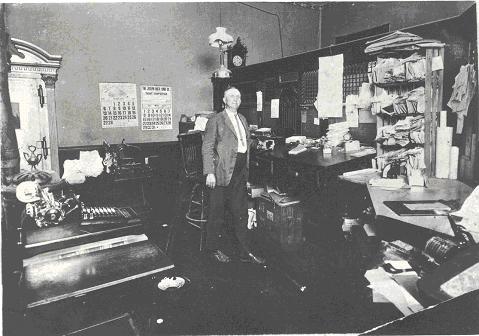
Richard B. Young, 1927
Cashier of Farmers Deposit Bank, 1906 -
1953
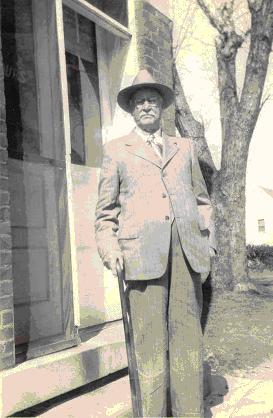
Lincoln Wells, about 1952, on the banks
front steps
A Founding Director and President of
Farmers Deposit Bank, 1936 1953
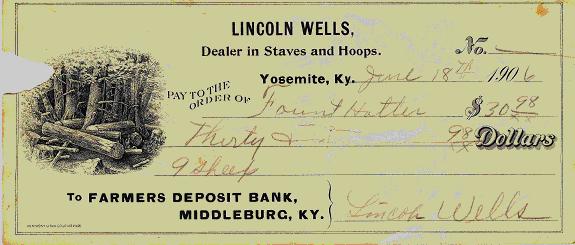
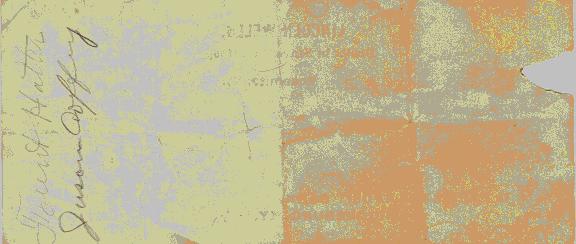
An early check drawn on the Farmers Deposit
Bank
On June 18, 1906 Lincoln Wells, president
of the bank from 1936 to 1953, paid Fountain (Fount) Hatter $30.98 for 9
sheep.
Jason Coffey, president of the bank from
1923 to 1936, cashed the check, presumably in his store in Yosemite.
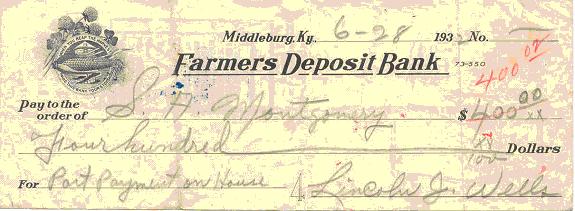
An example of another early check style
from 1932
Adams, J.S. 11
Allen, Elmer -- 8
Anderson, Jessie (Hatter) 2
Ashley, Sol 11, 13
Atwood, Mrs. ? -- 14
Bastin, C. 11
Bowman, Os 13
Carman, L. 11
Carman, Otis. L. 11, 14
Carman, W. 11
Carman, W.D. 11
Carr, Jean Elliott 13
Coffey, James K. (J.K.) 4, 6, 11
Coffey, Jason 4, 6, 9, 13, 16
Coffey, Wauda (Hatter) 2, 9, 13
Coulter, J.C. 11
Coulter, W.T. 11
Creech, Dr. C.B. 12, 13
Creech, Mrs. C.B. 13
Davis, ? (Professor) 2
Drye, George W. 11
Earles, W.T. 11
Elliott, Ann 9
Elliott, David 4
Elliott, George 9
Elliott, James 9, 11
Elliott, Janet 13
Elliott, Martha 13
Elliott, Maurine Coffey 9
Elliott, Maxine Coffey 9
Elliott, Oscar 4, 11
Elliott, Susan Dell 9
Falconberry, Alf T. 11
Floyd, Dr. D.S. 11, 12
Fogle, J.E. 11
Fogle, Mary 11
French, Berry 11, 13
Gadberry, Elzie 7, 8
Gadberry, J.F. -- 11
Gibbony, James 11, 13
Godbey, Clay 2
Godbey, Della 5, 11
Godbey, Ephraim (E.J.) 2, 3, 4, 11
Godbey, Ewart 5
Godbey, Jeff 2
Haney, Dr. J.N. 3, 11
Hatter, Fountain F. 2, 4, 16
Hatter, William Green (W.G.) 2
Keeney, W.P. 11, 13
Kelsay, E.E. 6, 11
Land, Al 13
Lawhorn, Belle 6
Lawhorn, J. Sherman 2, 5
Lay, J.C. 11, 12
Lucas, F.B. 11
Lucas, W.E. 11
McAninch, Clell 7
McAninch, Howe (H.H.) 3, 11, 13
McClure, Col. ? 13
McClure, Hattie Mitchell 13
McClure, W.S. 11
McClure, William S. 3, 4, 11, 13, 14
McIntosh, Stanley 8
McKinley, H.E. 11
McWhorter, J.S. 11
McWhorter, Malvina 11
McWhorter, Marshall 8
Miller, Preston 2
Miller, Tom 2
Miller, Tommy 2
Newell, John 4
Patterson, W.M. 11
Pike, Effie 11
Powell, Lillie Wells (Mrs. Smith T.) 9
Pruitt, C.L. -- 11
Riggins, Jim 8
Royalty, Betty 8
Settles, Mildred 10
Short, Homer 8, 11
Short, Irvin 4
Sweet, Glenn 11
Tapscott, Minnie 13
Taylor, J.S. 11
Thomas, C.D. 11
Thomas, David (D.A.) 3, 11
Wells, Bobby 9
Wells, Harold 9
Wells, J.P. 11
Wells, Jack 9, 10
Wells, Lincoln 4, 9, 11, 15, 16
Wells, Lincoln J. (Josh) 9, 16
Wesley, Dr. J.T. 2, 3, 11, 12, 14
Wesley, H. Clay 11
Wesley, Isariah - 2
Wesley, Silas 11
Wheat, Bill 4
Wheat, Jennie 4
Whipp, John Ashley 13
Young, Anna 8
Young, Eleanor 8
Young, George W. (Bill) 8, 10
Young, Lucien 8
Young, Lynn Hansford (Mrs. R.B.) 4, 9,
10, 13
Young, Mary Douglas 8
Young, Ray 8
Young, Richard B. 4, 6, 7, 8, 10, 12,
14, 15
Young, Virginia 8